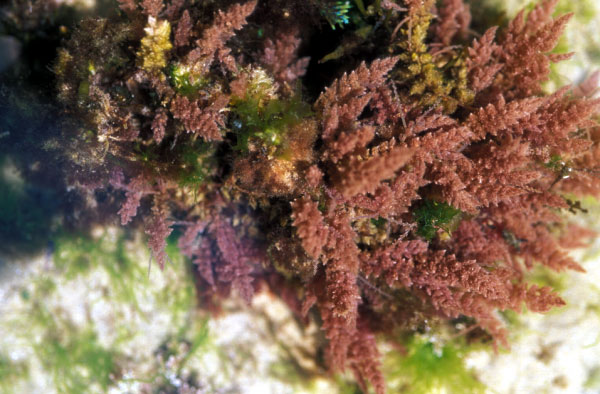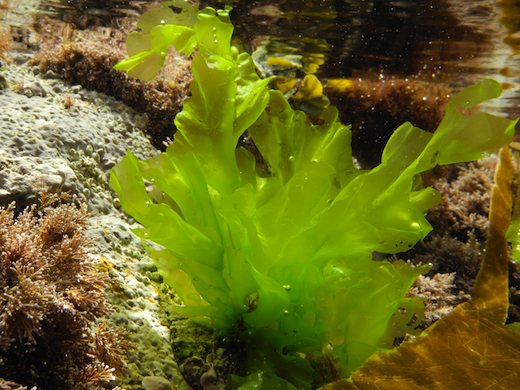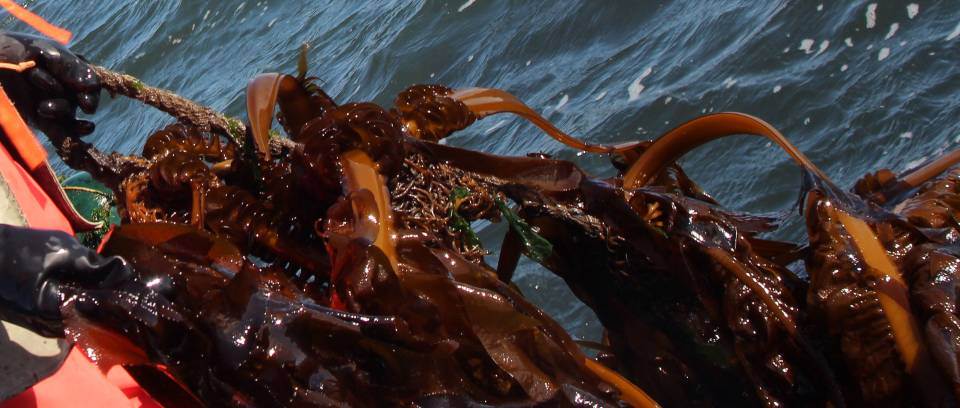The red alga Gracilaria lemaneiformis was cultured under different CO2 and phosphorus conditions for 16 days, and its growth, photosynthesis and uptake of nitrate and phosphate were examined in order to establish the longer-term impacts of elevated CO2 and phosphorus supplies on this economically important seaweed. Enrichment with either CO2 or phosphorus in culture markedly increased the growth of G. lemaneiformis compared to the control. Light-saturated photosynthetic rate was enhanced significantly by phosphorus enrichment, but hardly affected by the elevation of CO2 when G. lemaneiformis was grown under low phosphorus conditions. High phosphorus stimulated photosynthetic inorganic carbon utilization and nitrogen uptake. Under low phosphorus conditions, the thalli grown at the high level of CO2 had a lower carbon utilization capacity and a higher nitrogen uptake rate compared to those grown under ambient CO2. Reversed results were found when the algae were grown under high phosphorus conditions. Hence, available phosphorus may regulate inorganic carbon utilization of G. lemaneiformis grown at different CO2 levels, and growth reflected a balance between carbon and nutrient metabolism. Chinese 973 Projects [2009CB421207]; National Natural Science Foundation of China [30970450, 30670396]; Chinese 863 Projects [2006AA10A416]
Digital library
-
-
The study aimed to determine the sensory qualities and selling price of fish balls with the different levels of seaweed (Eucheuma spinosum). Five treatments were applied in this study; Control (0 seaweed), T1 (25% seaweed), T2 (50% seaweed), T3 (75% seaweed), and T4 (100% seaweed). Experimental samples were laid out using a completely Randomized Design (CRD). Different samples were subjected to sensory evaluation and selling price determination. Results were analyzed using ANOVA and DMRT when treatments were found to be significantly different from each other. Results revealed that different combinations of fish and seaweeds significantly affected the sensory qualities of fish balls in terms of color, aroma, flavor, texture and general acceptability. The treatment with the least amount of seaweed added showed the highest sensory score in all the sensory parameters.
-
This study was conducted to investigate the effects of brown seaweed (Undaria pinnatifida) by-product and seaweedfusiforme (Hizikia fusiformis) by-product supplementation on growth performance and blood profiles includingserum immunoglobulin(Ig)in broilers. Fermentation of seaweeds was conducted byBacillus subtilisandAspergillus oryzae. In a 5-wk feeding trial, 750 one-d-old broiler chicks were divided into 5 groups, and were assigned to the control diet or experimental diets including control+0.5%brownseaweed (BS)by-product, control+0.5%seaweed fusiforme (SF)by-product, control+0.5%fermented brown seaweed (FBS)by-product, and control+0.5%fermented seaweed fusiforme (FSF)by-product. As a consequence,body weight gain (BWG) and gain:feedof seaweed by-product groups were clearlyhigher, when compared to those of control diet group from d 18 to 35 and the entireexperimental period (p<0.05). In mortality rate, seaweed by-product groups were significantly lower when compared to control dietgroup during entire experimental period (p<0.05). However, Feed Intake of experimental diets group was not different from that of thecontrol group during the entire experimental period. Whereas, Feed Intake of fermented seaweed by-product groups was lower than thatof non-fermented seaweed groups (p<0.05). Total organ weights, lipids, and glutamic oxalacetic transaminase (GOT) of all treatmentgroups were not different from those of control group. However, glutamic pyruvate transaminase (GPT) of all treatment groupswashigher than that of control group at d 17 (p<0.05). In case of serum Igs concentration, the concentration of IgA antibody in BS, SF, FSFtreatment groups was significantly higher than in control group at d 35 (p<0.01). IgA concentration in FBS supplementation groups wasnegligiblydecreased when compared to the control group. IgM concentration in the serums of all treatment groups was significantlyhigher than in control group (p<0.05) and in fermented seaweed by-product groups were much higher than in non-fermented seaweedgroups (p<0.05). On the other hand, IgG concentrations in all treatment groups were lower than in control group (p<0.05). Takentogether, our results suggest that by-productdietary supplementationof BS, SF, FBS, and FSF in poultry may provide positive effects ofgrowth performance and immune response.
-
Benthic primary producers in marine ecosystems may significantly alter biogeochemical cycling and microbial processes in their surrounding environment. To examine these interactions, we studied dissolved organic matter release by dominant benthic taxa and subsequent microbial remineralization in the lagoonal reefs of Moorea, French Polynesia. Rates of photosynthesis, respiration, and dissolved organic carbon (DOC) release were assessed for several common benthic reef organisms from the backreef habitat. We assessed microbial community response to dissolved exudates of each benthic producer by measuring bacterioplankton growth, respiration, and DOC drawdown in two-day dark dilution culture incubations. Experiments were conducted for six benthic producers: three species of macroalgae (each representing a different algal phylum: Turbinaria ornata – Ochrophyta; Amansia rhodantha – Rhodophyta; Halimeda opuntia – Chlorophyta), a mixed assemblage of turf algae, a species of crustose coralline algae (Hydrolithon reinboldii) and a dominant hermatypic coral (Porites lobata). Our results show that all five types of algae, but not the coral, exuded significant amounts of labile DOC into their surrounding environment. In general, primary producers with the highest rates of photosynthesis released the most DOC and yielded the greatest bacterioplankton growth; turf algae produced nearly twice as much DOC per unit surface area than the other benthic producers (14.062.8 mmol h21 dm22), stimulating rapid bacterioplankton growth (0.04460.002 log10 cells h21) and concomitant oxygen drawdown (0.1660.05 mmol L21 h21 dm22). Our results demonstrate that benthic reef algae can release a significant fraction of their photosynthetically-fixed carbon as DOC, these release rates vary by species, and this DOC is available to and consumed by reef associated microbes. These data provide compelling evidence that benthic primary producers differentially influence reef microbial dynamics and biogeochemical parameters (i.e., DOC and oxygen availability, bacterial abundance and metabolism) in coral reef communities.
-
Seaweeds are ecologically important primary producers, competitors, and ecosystem engineers that play a central role in coastal habitats ranging from kelp forests to coral reefs. Although seaweeds are known to be vulnerable to physical and chemical changes in the marine environment, the impacts of ongoing and future anthropogenic climate change in seaweed- dominated ecosystems remain poorly understood. In this review, we describe the ways in which changes in the environment directly affect seaweeds in terms of their physiology, growth, reproduction, and survival. We consider the extent to which seaweed species may be able to respond to these changes via adaptation or migration. We also examine the extensive reshuffling of communities that is occurring as the ecological balance between competing species changes, and as top-down control by herbivores becomes stronger or weaker. Finally, we delve into some of the ecosystem- level responses to these changes, including changes in primary productivity, diversity, and resilience. Although there are several key areas in which ecological insight is lacking, we suggest that reasonable climate-related hypotheses can be developed and tested based on current information. By strategically prioritizing research in the areas of complex environmental variation, multiple stressor effects, evolutionary adaptation, and population, community, and ecosystem-level responses, we can rapidly build upon our current understanding of seaweed biology and climate change ecology to more effectively conserve and manage coastal ecosystems.
-
Benthic marine algae, especially Rhodophyta, are within a well-known marine group able to produce secondary metabolites with bioactive properties. Among them are halogenated terpenes, synthesized by vanadium-dependent haloperoxidase (V-BPO). The red alga Ochtodes secundiramea (Montagne) M. Howe produces high amounts of halogenated monoterpenes (HMT) which have the potential to control phytopathogenic fungi. Culture closed a system is a tool used to manipulate conditions to increase the synthesis of HMT and other metabolites. The apical segments of O. secundiramea were cultivated in a bioreactor, either in seawater enriched with half strength von Stosch’s solution (VSES/2) without (control) and with the addition of 250 mg L−1 bromine (treatment). In response to these conditions, specific growth rate, HMT profile, soluble protein, phycobiliproteins, soluble carbohydrate, and chlorophyll as well as the V-BPO activity, uptake, and accumulated bromine within the biomass were evaluated. The treatment did not promote significant alterations in the growth but increased the V-BPO activity and bromine uptake and incorporation (2.5 fold). No changes in the HMT profiles of the extracts from both cultures conditions were observed by gas chromatography–mass spectrometry analyses, whereas the values of total soluble protein and phycobiliproteins were 2- fold higher in samples from the bromine-enriched medium when compared to samples from control. These results support the evidences of protective effects promoted by V-BPO activity. Furthermore, carbohydrate and chlorophyll contents were not affected by experimental conditions. These results provided new low-cost strategies that can be applied to increase of certain biomass components, which here are algal proteins, especially in Rhodophyta-based biotechnological industries for food and agriculture.
-
Experiments were conducted in Mayagüez, Puerto Rico, to assess the effects of a commercially available extract of the brown alga Ascophyllum nodosum on ‘Palmer’ and ‘Parvin’ mangos grown for transplants. The extract was soil-applied biweekly at 0 to 5 ml/L, using 150 ml of aqueous solution per plant per application. Both varieties responded similarly to the alga extract. Increasing the extract rate resulted in increased leaf chlorophyll content (up to 25% higher) and accelerated scion shoot height gain (up to 22%). These results indicate that Ascophyllum alga extracts can be used to reduce the time necessary to grow mango transplants.
-
The use of supercritical methanol (scMeOH) for the liquefaction of the carbohydrate-rich macroalgae Saccharina japonica was investigated at low temperature (250–300 °C). At 300 °C, almost complete conversion (98.1 wt%) and a high bio-oil yield (66.0 wt%) were achieved. These values are higher than those achieved with super- critical ethanol (scEtOH, 87.8 wt% conversion, 60.5 wt% bio-oil yield) and subcritical water (subH2O, 91.9 wt% conversion, 40.3 wt% bio-oil yield) under identical reaction conditions. The superior liquefaction in scMeOH is attributed to the beneficial physical properties of scMeOH, including its higher polarity, superior reactivity, and higher acidity. The superior reactivity of scMeOH was evident from the larger amount of esters (54.6 area%) produced in scMeOH as compared to that in scEtOH (47.2 area%), and the larger amount of methyl/methoxy- containing compounds (78.6 area%) produced in scMeOH than that of ethyl/ethoxy-containing compounds (58.2 area%) produced in scEtOH. The higher bio-oil yield combined with its higher calorific value (29.2 MJ kg−1) resulted in a higher energy recovery of 135% for scMeOH as compared to those of scEtOH (118%) and subH2O (96%). When considering the amount of alcohol consumed during the liquefactions and the production of light bio-oil fractions that evaporate during bio-oil recovery, the higher methanol consumption (5.3 wt%) than that of ethanol (2.3 wt%) leads to similar bio-oil yields (∼51 wt%).
-
A cage culture system was previously developed for the red alga Gracilaria parvispora Abbott on Molokai, HI; however, yields have shown marked variation, even among cages with identical stocking rates and fertilization treatments. Water motion, which can be affected by location and arrangement of the cages in the grow-out area, was hypothesized to be a factor contributing to the variation in yield. To examine this, the growth rates of thalli and the development of sporelings in relation to water motion were determined in replicated trials both in tanks and in small-scale field experiments.Generally, water motion had a substantial effect on both thallus growth rate and spore development. In the tank cultures of thalli, water velocities ranged up to 13.7 cm s−1, and relative growth rates (RGRs) ranged from 2.8% to 8.9% day−1. In the lagoon, water velocities ranged between 3.6 and 11.6 cm s−1. Relative growth rates of the thalli in the lagoon trials were 0.02–10.3% day−1. Sporeling density, a measure of spore development, was also significantly affected by water motion. In the tank trials, water motion ranged from near 0 to 6.50 cm s−1, and sporeling densities ranged from 1.4 cm−2 at lower water motion levels to 11.6 sporelings cm−2 at higher levels. Similar results were obtained in lagoon trials, with sporeling densities ranging from 0.2 to 6.7 cm−2. However, sporeling length was not significantly correlated with water motion. In previous trials, we have been able to achieve high sporeling densities, but elongation of sporelings has been inhibited. In the present trials, we were able to break the apparent sporeling dormancy by incubating the sporelings in tanks enriched in nutrients supplied by fish cultures. Consideration of the effects of water motion is important in designing culture systems for species of Gracilaria and other marine algae. The results also suggest that nutrients play a key role in regulating the early development of G. parvispora sporelings.
-
Effect of thermal stress on the liberation of tetraspores from Gelidium pusillum (Stackhouse) LeJolis, PterocladiLl heteroplatos (Boergesen) Umamaheswara Rao and Kaliaperurna.l and Gelidiopsis variabilis( Greville) Schmitz was studied. in response to temperatures lower (0° -lOOC)and higher( 40° -45°C)than the tolerance limits of plants. Spore liberation was seen in these algae exposed to low and high temperatures for short durations but the output decreased with increase in the duration of treatment. The temperature tolerance capacity varied in the algae tested.





